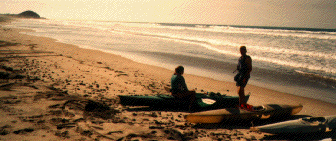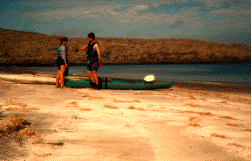As with any entry on the Pacific, surf can pose a real problem for getting out if the swell is large, at least these beaches are free from the rocks that dominate the coast just to the north and south.

Beach Launch
The paddle out was quite pleasant, wind and seas were calm and the volcano on the island gradually grew till we could make out more detailed features of the coastline.

The approach to the island
Since none of us had been out to this island, we weren't sure where we were going to camp. Todos Santos, another island further north, had some small bays and we were hoping to find something similar (look for pages about a trip to the Coronado islands proving the dangers of such assumptions, coming soon). We encountered a beautiful small bay/lagoon on the southeast side. The enterance to it was a little difficult to see at first as it's entrance is only a gap (about 25 meters) in a natural sea wall of large volcanic rocks. Even though it is on the east side, a moderate swell may be breaking across the entrance. There can also be considerable tidal flow so caution should be used when approaching it.

Rocky Entering lagoon
The lagoon has a nice beach on the south side and mud/rock beaches on the remaining sides. There are some low dunes behind the beach leading to the natural sea wall. When we first entered the lagoon we were greeted by 30-50 sea lions that had been playing in the water or sunning themselves on the rocks. All their curious heads bobing in the water staring at us was quite a sight. When they decided to leave as we came in they had to race right by us in the narrow enterance to the lagoon.
If you enter at anything other than high tide be sure to pull your boat up to the level of the dune vegetation as the slope of the beach is quite shallow and the water advances/recedes greatly with the tide change.

Rocky and Tracy on beach
Next Page




